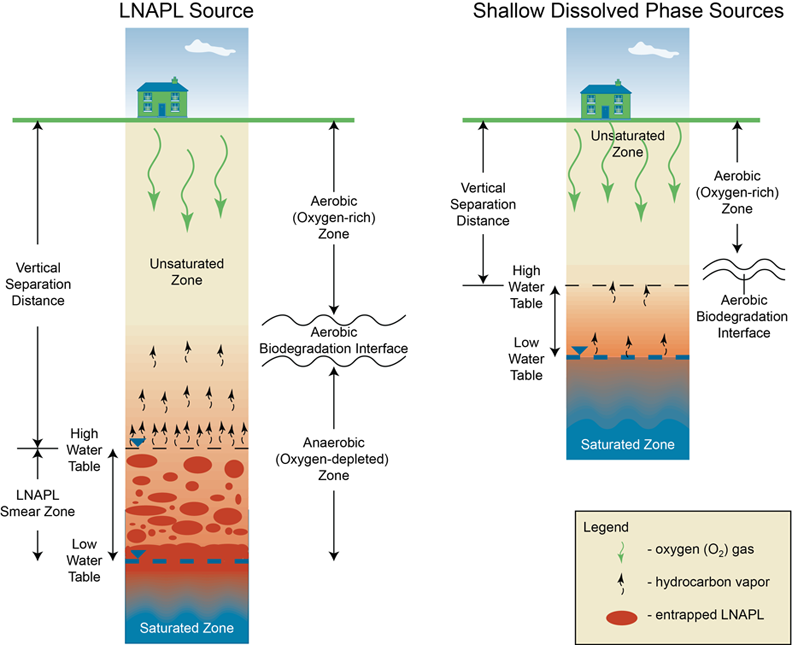
This chapter describes a method for PVI screening based on the vertical distance from a petroleum vapor source to a building foundation (vertical separation distance). Application of the method is expected to improve PVI screening and reduce unnecessary data collection at numerous petroleum release sites. The vertical screening distance is the minimum thickness of soil between a petroleum vapor source and building foundation necessary to effectively biodegrade hydrocarbons below a level of concern for PVI (see Figure 3-1). The vertical screening distances are based on empirical studies involving data collected at hundreds of petroleum release sites (see Appendix F). Method application requires the development of a preliminary CSM based on soil and groundwater data collected as part of an initial site investigation or from valid preexisting data.

Conceptual model of petroleum vapor transport for an LNAPL source and a dissolved phase source.
The PVI screening process is divided into three steps (see Figure 3-2):
Step 1: Develop a Preliminary CSM: The preliminary CSM is based on critical data obtained from an initial site investigation or valid preexisting data. Critical data include soil and groundwater data, type of site (petroleum UST/AST or petroleum industrial), type of vapor source (dissolved-phase or LNAPL), vertical separation distance, and the presence of site-specific factors that would preclude the use of the screening process. Note that if COC concentrations in soil and groundwater are below existing PVI regulatory criteria, the development of a preliminary CSM and use of a vertical screening distance are not required and no further PVI evaluation is needed.
Step 2: Evaluate Site for Precluding Factors and Lateral Inclusion: If precluding factors are present, then investigate the site further (Chapter 4, Appendix G) or implement vapor control and site management (Chapter 6). If there are no precluding factors, evaluate whether current or future buildings are located within the lateral inclusion zone. If buildings are located within the lateral inclusion zone, continue to Step 3 for further screening. Buildings outside of the lateral inclusion zone require no further PVI evaluation.
Step 3: Screen Building Using Vertical Separation Distance: Assess whether further site investigation is necessary based on the measured vertical separation distance between the building foundation and the top of the petroleum vapor source in soil or groundwater.
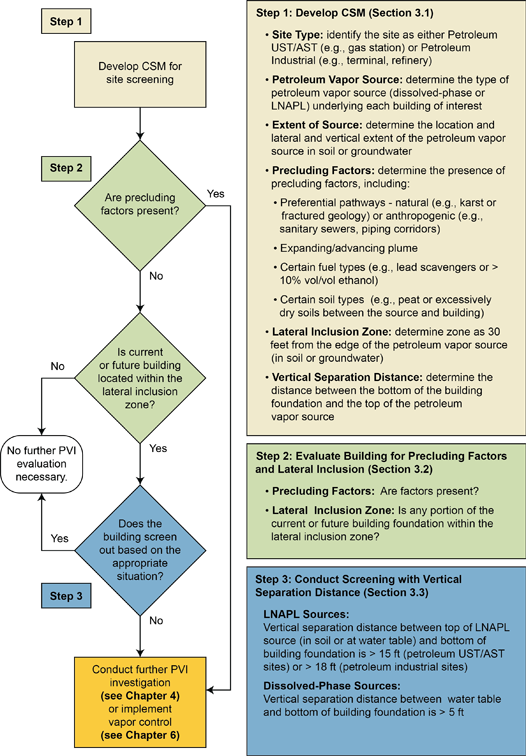
Flowchart for PVI screening application.
The preliminary CSM is developed by collecting soil and groundwater data as part of routine initial site investigations. The CSM necessary for PVI screening has the following components:
USEPA (2013a) has published empirical studies that reported different LNAPL screening distances based on facility type:
This document addresses all petroleum facilities (see Appendix E), and therefore a slightly modified site classification is needed to guide selection of the appropriate LNAPL vertical screening distance:
Differences in the vertical screening distances according to site type may relate to the volume of the LNAPL release or extent of the LNAPL plume. Large releases of petroleum can result in a large oxygen demand, which reduces biodegradation of the PHCs. Petroleum industrial sites tend to have large infrastructure and may have multiple releases from different locations, which can also exert a high oxygen demand. Given that LNAPL release volumes and plume extents may not always correlate with the site type, a good CSM and professional judgment are needed to select the most appropriate LNAPL vertical screening distance. Note that there is more uncertainty associated with the industrial sites because a relatively small data set of industrial sites was used in the empirical study (USEPA 2013a).
The empirical studies of Lahvis et al. (2013a) and USEPA (2013a) found that vertical screening distances are longer for LNAPL sources than for dissolved-phase sources. Greater vertical source separation is necessary to biodegrade PHC vapors below a level of concern for PVI for LNAPL sources than for dissolved-phase sources because LNAPL sources can generate higher concentrations of vapors. As a result, there is greater demand for O2 in the vadose zone during aerobic biodegradation of LNAPL sources compared to dissolved-phase sources. Both LNAPL and dissolved-phase sources may be present from a single release.
Source identification can be challenging at locations where LNAPL is present as a residual-phase source in soil or groundwater because the LNAPL may not be readily apparent unless there is measurable thickness of LNAPL in a nearby groundwater monitoring well. In these cases, a multiple-lines-of-evidence approach can be used for LNAPL identification (see Table 3-1). The LNAPL indicator criteria and parameter ranges are values reported in the literature. Presence of LNAPL may be indicated by one or more of the parameters shown in Table 3-1. Measurable PHC concentrations in groundwater less than those indicative of LNAPL are consistent with a dissolved-phase petroleum vapor source. PHC concentrations in soil or groundwater can vary widely depending on the LNAPL type (gasoline, diesel, jet fuel) and the degree of weathering. The indicator criteria provided in Table 3-1 should thus be used as general guidance. Regulatory agencies may have their own set of criteria for LNAPL identification.
|
Indicator 1 |
Comments |
|---|---|
|
Groundwater |
|
|
There is not a specific PHC concentration in groundwater that defines LNAPL because of varying product types and degrees of weathering. |
|
Soil |
|
|
|
|
Location relative to UST/AST |
|
|
The probability of encountering LNAPL increases closer to a known or suspected release. |
|
Notes: 1 One or more of these indicators may be used to define LNAPL. 2Value used in the derivation of screening distances by USEPA (2013a) and Lahvis and Hers (2013b). 3 Value used in the derivation of screening distances by Peargin and Kolhatkar (2011). 4 Value used in the derivation of screening distances by USEPA (2013a). 5 Value recommended by Lahvis and Hers (2013b). 6 Value is from ASTM E2531-06. 7 Value recommended by USEPA (2013a) and Lahvis and Hers (2013b). |
|
Proper delineation of the petroleum vapor source in soil or groundwater is critical in determining which buildings are within the lateral inclusion zone (see
Utilities in LNAPL Zones
There is a significantly greater risk of PVI from utilities located within LNAPL zones than there is with dissolved groundwater plumes.
The presence of any of the precluding factors listed below will direct the investigator out of the site screening process and require either further investigation (Chapter 4) or vapor control and site management (Chapter 6). Typical precluding factors include the following:
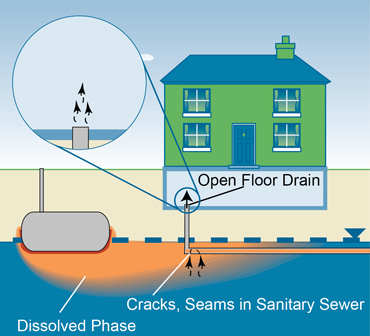
Precluding factor: conduit intersecting source and entering building.
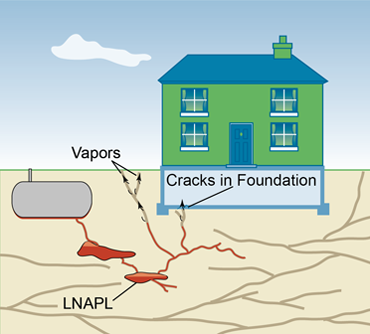
Precluding factor: fractured or karst geology.
The lateral inclusion zone is used to determine whether a building is close enough to the lateral edge of a petroleum vapor source to be considered for PVI screening. The lateral inclusion zone is defined as the area from the edge of the petroleum vapor source to the edge of a building foundation. Identifying the edge of the petroleum vapor source depends on how the extent of the source is defined by individual governing state or local regulatory requirements. Wilson et al. (2013) describe an interpolation method for sites where plume delineation and lateral inclusion zone are uncertain. This method is based on interpolation of contaminant concentrations between monitoring locations.
Little empirical data are available from the literature to help define the lateral inclusion zone or distance of vapor attenuation in the lateral direction. Nonetheless, lateral inclusion distances and vertical screening distances should be approximately the same, because the physical processes acting on PHC vapor plumes (mass flux from the source, oxygen demand, and biodegradation) are generally the same in the vertical and horizontal directions (USEPA 2013n). The vertical screening distances are expected to apply laterally in the absence of preferential pathways or significant hydrogeologic barriers (such as perched water tables or low-permeability soil lenses) that could enhance lateral migration of PHC vapors. Modeling studies by the American Petroleum Institute (API 2009) support this assumption. The lateral edge of a contaminant plume, however, is generally not known with the same degree of certainty as the vertical edge because plume delineation is conducted over a scale of tens of feet laterally, compared to a only a few feet vertically.
A conservative, 30-foot lateral inclusion distance may be considered appropriate to incorporate the uncertainty. If a high degree of confidence exists in the delineation of the lateral edge of the source, it may be appropriate to use the applicable vertical screening distance to define the lateral inclusion zone.
The vertical separation distance is measured from the top of the petroleum vapor source to the bottom of the building foundation for each building located within the lateral inclusion zone. Seasonal and long-term fluctuations in groundwater levels should be considered when determining the depth to the LNAPL smear zone or dissolved phase source. A consideration of current and historical land use is recommended for buildings located in the lateral inclusion zone in order to assess the potential for additional (secondary) sources that are not associated with the primary release under investigation. Vertical separation distance should be determined from the top of the source closest to the building foundation where these additional (secondary) sources are identified.
Note that the soil within the vertical separation distance may contain detectable concentrations of PHCs, which typically do not interfere with biodegradation (because the soil does not contain LNAPL source material). This condition is consistent with the petroleum vapor transport CSM shown in Figure 3-1.
Vertical screening distances can only be applied in the absence of any precluding factors identified in the preliminary CSM (
Several empirical studies have defined vertical screening distances for LNAPL and dissolved-phase sources (see Appendix F). As previously noted, there is more uncertainty with the industrial sites because of the relatively small data set of industrial sites in the empirical study (USEPA 2013a). Although the values derived for dissolved-phase and LNAPL sources vary slightly among the studies, they can be conservatively defined as:
Determine whether the vertical separation distance between the top of the petroleum vapor source and the bottom of the building foundation exceeds these vertical screening distances for either an LNAPL source (see Figure 3-5) or a dissolved-phase source (see Figure 3-6). If so, then no further evaluation of the PVI pathway is necessary. If not, then further site investigation (Chapter 4) or vapor control and site management (Chapter 6) is necessary.
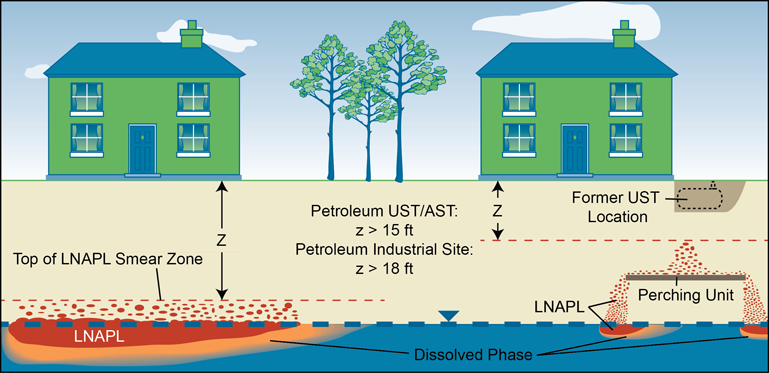
Vertical screening distances for LNAPL source.
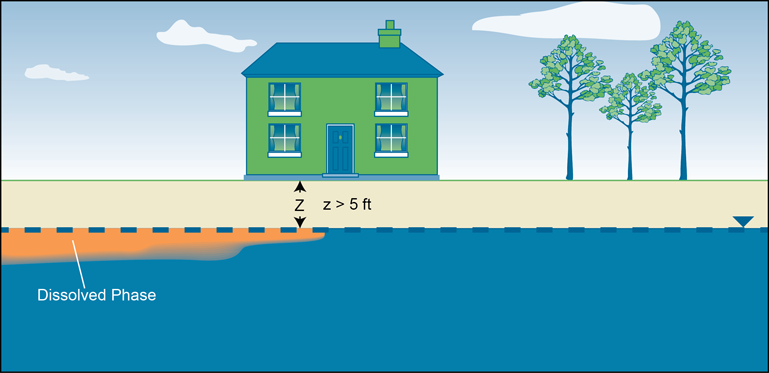
Vertical screening distances for dissolved-phase source.